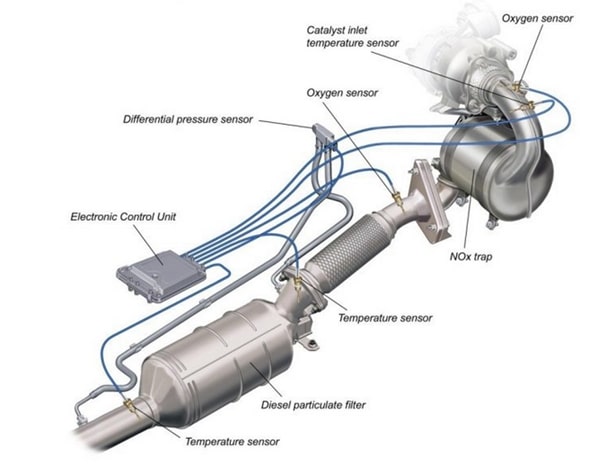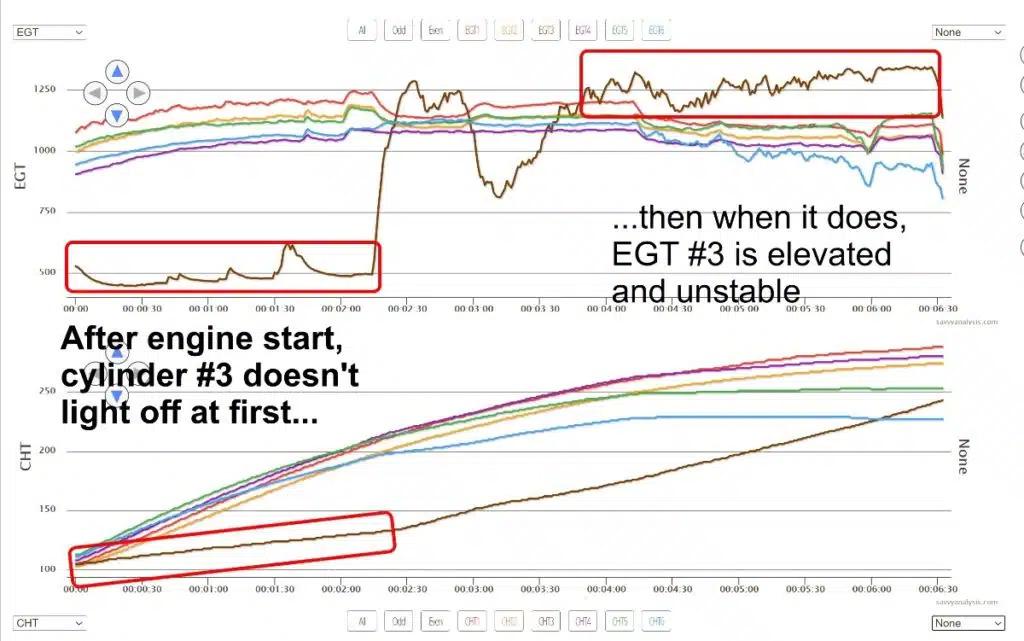If you own a Ram 2500 with a diesel engine, particularly the Cummins 6.7L, you’ve likely heard about the exhaust gas temperature (EGT) sensor and its importance.
The normal EGT range for a Ram 2500 Cummins is 300–600°F at idle, 600–900°F cruising, and 900–1200°F towing. Modified trucks may hit 1300°F. Monitor with an EGT gauge.
In this guide, we’ll dive into what the EGT sensor does, the typical temperature ranges for a Ram 2500, factors that influence these readings, and tips for keeping your sensor in top shape.
What Is an EGT Sensor and Why Does It Matter?
The EGT sensor, or exhaust gas temperature sensor, measures the temperature of the exhaust gases exiting your Ram 2500’s engine.
This data is sent to the engine control module (ECM), which uses it to regulate engine performance, protect components like the turbocharger and diesel particulate filter (DPF), and manage emissions.
In a diesel truck like the Ram 2500, high exhaust temperatures can signal potential problems, such as over-fueling, turbo issues, or a clogged DPF.
Without a properly functioning EGT sensor, your truck could face serious issues:
- Engine Damage: Excessive heat can harm the turbo, pistons, or exhaust system.
- Reduced Efficiency: Incorrect readings may cause the ECM to misadjust fuel delivery, lowering fuel economy.
- Emissions Problems: A faulty sensor can trigger DPF regeneration issues, leading to limp mode or check engine lights.
For Ram 2500 owners, knowing the normal EGT range helps you spot trouble early, whether you’re towing heavy loads, idling, or pushing the engine during off-road adventures.
Normal EGT Range for Ram 2500

The normal EGT range for a Ram 2500 with a Cummins 6.7L diesel engine depends on driving conditions, load, and modifications. Below are the typical ranges based on real-world data and owner experiences from forums and technical resources:
- Idle or Light Driving: At idle or during light cruising (e.g., highway driving with no load), EGTs typically range from 300°F to 600°F (149°C to 316°C). These lower temperatures reflect minimal engine stress.
- Moderate Driving: Under normal driving conditions, such as city driving or light towing, EGTs usually fall between 600°F and 900°F (316°C to 482°C).
- Heavy Towing or Hard Acceleration: When towing heavy loads or accelerating aggressively, EGTs can climb to 900°F to 1200°F (482°C to 649°C). For stock Ram 2500s, staying below 1250°F is generally considered safe.
- Extreme Conditions: In high-performance scenarios (e.g., modified trucks with tuned ECMs or larger turbos), EGTs may briefly hit 1300°F to 1500°F (704°C to 816°C), but sustained temperatures above 1350°F can risk turbo or engine damage.
Important Note: These ranges apply to stock Ram 2500s with the 6.7L Cummins engine (common in models from 2007 to 2025). If your truck has aftermarket modifications like a performance tune, larger turbo, or deleted DPF, EGTs may run higher, and safe limits could differ. Always consult your tuner or mechanic for modified setups.
Read More: How Many Dodge Ram SST Were Made – You Must Know!
Factors That Affect EGT Readings
Several factors influence EGT sensor readings on a Ram 2500. Understanding these can help you interpret whether your temperatures are normal or a sign of trouble:
- Driving Conditions:
- Towing: Heavy trailers increase engine load, pushing EGTs higher. For example, towing a 15,000-pound trailer up a steep grade could push EGTs toward 1200°F or more.
- Ambient Temperature: Hot weather can elevate EGTs, while cold weather may keep them lower.
- Altitude: Higher altitudes reduce air density, which can increase EGTs due to less efficient combustion.
- Engine Modifications:
- Tunes: Performance tunes that increase fuel delivery or boost can raise EGTs significantly.
- Exhaust Upgrades: Aftermarket exhaust systems or DPF deletes may lower EGTs by improving flow but can also alter sensor readings.
- Turbochargers: Upgraded turbos may produce higher or lower EGTs depending on their efficiency.
- Maintenance Issues:
- Clogged DPF: A restricted diesel particulate filter can cause EGTs to spike during regeneration cycles.
- Fuel System Problems: Over-fueling or injector issues can lead to abnormally high EGTs.
- Sensor Failure: A faulty EGT sensor may give inaccurate readings, either too high or too low.
- Driving Style:
- Aggressive acceleration or lugging the engine (running at low RPMs under heavy load) can cause EGT spikes. For example, staying in too high a gear while towing can push EGTs beyond safe limits.
How to Monitor EGTs on Your Ram 2500
To keep an eye on your EGT sensor values, you’ll need a way to read the data. Here’s how Ram 2500 owners typically monitor EGTs:
- OBD-II Scanners: Devices like the BlueDriver or Torque Pro, paired with an app, can display real-time EGT readings via the truck’s OBD-II port.
- Aftermarket Gauges: Installing an aftermarket EGT gauge (e.g., Edge Insight CTS3) provides a dedicated display for EGTs and other parameters. These often use a thermocouple probe installed in the exhaust manifold or downpipe.
- Factory Displays: Some newer Ram 2500 models (2020+) include EGT readouts in the digital instrument cluster, though they may not show precise values.
For the most accurate monitoring, install a pyrometer probe before the turbocharger, as this location reflects the hottest exhaust gases. Post-turbo probes may show lower readings due to heat dissipation.
Signs of Abnormal EGT Readings

If your EGTs fall outside the normal range, it could indicate a problem. Here are common symptoms and their causes:
- EGTs Too High (Above 1350°F for Stock Trucks):
- Cause: Clogged DPF, over-fueling, or excessive boost from a tune.
- Action: Check the DPF status, reduce load, or consult a mechanic to inspect the fuel system or turbo.
- EGTs Too Low (Below 300°F at Idle):
- Cause: Faulty EGT sensor, wiring issues, or ECM problems.
- Action: Test the sensor with a multimeter or replace it if readings are inconsistent.
- Erratic Readings:
- Cause: Loose connections, damaged sensor, or ECM glitches.
- Action: Inspect wiring harnesses and consider a diagnostic scan to check for fault codes (e.g., P0546 for EGT sensor circuit issues).
If you notice a check engine light with codes related to the EGT sensor (e.g., P242F for DPF restriction or P0545/P0546 for sensor faults), address them promptly to avoid limp mode or engine damage.
Read Out: Dodge RAM 1500 Dies When Braking – Complete Guide!
Maintaining Your EGT Sensor
To ensure your Ram 2500’s EGT sensor provides accurate readings and lasts, follow these maintenance tips:
- Regular Inspections:
- Check the sensor and wiring for soot buildup, corrosion, or damage, especially after heavy towing or off-road use.
- Clean the sensor carefully with a non-abrasive cleaner if soot accumulates.
- Monitor DPF Health:
- A clogged DPF can cause EGT spikes. Follow the manufacturer’s maintenance schedule for DPF cleaning or regeneration.
- Consider a professional DPF cleaning service every 100,000 miles.
- Avoid Overloading:
- Don’t exceed your Ram 2500’s towing capacity (typically 17,000–20,000 pounds for the 6.7L Cummins, depending on configuration). Overloading stresses the engine and raises EGTs.
- Use Quality Fuel:
- Poor-quality diesel can lead to incomplete combustion, increasing EGTs. Stick to reputable fuel stations and consider additives for cleaner burning.
- Replace Faulty Sensors Promptly:
- EGT sensors typically cost $50–$150 for OEM replacements. If you suspect a failure, replace it to avoid misleading ECM data.
When to Seek Professional Help
If your EGT readings are consistently abnormal or you’re seeing related fault codes, it’s time to consult a diesel mechanic or dealership. Common scenarios requiring professional attention include:
- Persistent high EGTs despite reducing load or changing driving habits.
- Frequent DPF regeneration cycles or limp mode activation.
- Diagnostic trouble codes (DTCs) that don’t clear after replacing the sensor.
A mechanic can perform a full diagnostic, including checking the turbo, fuel injectors, and ECM calibration, to pinpoint the root cause.
5.9 Cummins EGT range
A 5.9 Cummins usually runs between 600°F and 1,200°F in normal driving. Heavy towing or climbing can push it to 1,300°F. Anything above 1,400°F for long periods can risk turbo or engine damage.
Normal EGT temp 6.7 Cummins
For a 6.7 Cummins, cruising EGTs are often around 600–800°F. Under load or towing, 1,000–1,200°F is normal. Short spikes to 1,350°F can happen, but staying lower is safer for long-term reliability.
What EGT is too high Cummins
EGT above 1,400°F for a long time can hurt a Cummins engine. Short bursts are fine, but constant high heat can damage pistons, valves, or the turbo. Keep temps in the safe range whenever possible.
6.7 Cummins EGT temps
A 6.7 Cummins runs about 600–800°F at cruise. Light towing may be 1,000–1,200°F. Heavy towing or hills can touch 1,300–1,350°F briefly. Avoid long runs over 1,400°F to protect engine parts and extend life.
12 valve Cummins EGT temps
A stock 12-valve Cummins cruises at 600–800°F. Working hard, like towing or pulling hills, it may reach 1,200–1,300°F. Over 1,400°F for more than a few seconds risks harming engine or turbo components.
Must Read: Will Dodge Truck Cap Fit Chevy – Find Out Here!
Max EGT 5.9 Cummins
The safe max for a 5.9 Cummins is about 1,300–1,350°F under load. Brief peaks to 1,400°F are possible, but sustained high heat can cause major engine or turbo damage. Keep within safe limits.
FAQs
What is the normal range of EGT sensor?
The normal EGT sensor range for a Ram 2500 Cummins is 300–600°F at idle, 600–900°F cruising, and 900–1200°F towing.
What is a high EGT for 6magenta
A high EGT for a 6.7 Cummins Ram 2500 is above 1250°F towing or 1350°F modified; it risks turbo and engine damage.
What are normal EGT levels?
Normal EGT levels for a Ram 2500 Cummins range from 300–600°F idle, 600–900°F driving, and 900–1200°F towing heavy loads.
What is a safe EGT range?
A safe EGT range for a Ram 2500 Cummins is 300–1200°F; below 1250°F towing is safe to avoid engine damage.
What are the symptoms of a bad EGT sensor?
A bad EGT sensor may cause erratic readings, check engine lights, limp mode, poor performance, or incorrect fuel delivery in your Ram 2500.
What happens if EGT gets too high?
If EGT gets too high, above 1350°F, it can damage the turbo, pistons, or exhaust system in a Ram 2500 Cummins.
How to test EGT sensors?
Test EGT sensors with a multimeter for resistance, check wiring, or use an OBD-II scanner to read live data on your Ram 2500.
What is low EGT margin?
Low EGT margin means temperatures below 300°F at idle, possibly due to a faulty sensor, wiring issues, or poor combustion.
What is the exhaust limit temperature sensor?
The exhaust limit temperature sensor, or EGT sensor, monitors exhaust gas heat to protect the Ram 2500’s engine and turbo.
What causes low EGT?
Low EGT in a Ram 2500 can be caused by a bad sensor, wiring issues, low fuel delivery, or cold weather.
Conclusion
Understanding the normal EGT sensor range for your Ram 2500 is crucial for maintaining its performance and longevity, especially if you tow heavy loads or run a modified setup. By keeping EGTs within 300°F to 1200°F under most conditions and addressing abnormal readings promptly, you can prevent costly damage to your engine, turbo, or exhaust system. Regular monitoring with a gauge or OBD-II scanner, combined with proper maintenance, ensures your Ram 2500 stays reliable on the road. If you’re ever unsure about your EGT readings or notice warning signs, don’t hesitate to consult a professional to keep your truck running strong.

